Greek Dark Age › Pizarro and Atahualpa: The Curse of the Lost Inca Gold » Origins and History
Articles and Definitions › Contents
- Greek Dark Age › Ancient History
- Pizarro and Atahualpa: The Curse of the Lost Inca Gold › Who Was
Ancient civilizations › Historical places, and their characters
Greek Dark Age › Ancient History
Definition and Origins
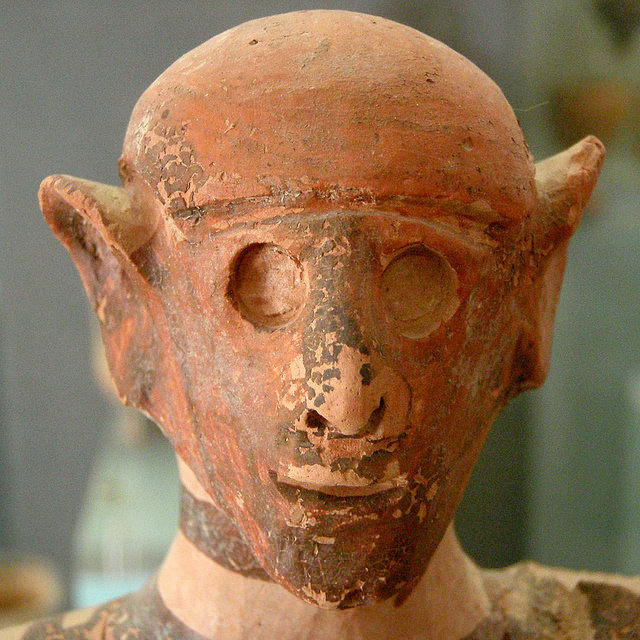
The Greek Dark Age is the interval between the collapse of the Mycenaean civilization, around 1200 BCE, and the GreekArchaic Period, around c. 800 BCE. The Dark Age era begins with a catastrophic event: the collapse of the Mycenaean civilization, when all major Mycenaean regional centres fell out of use after suffering a combination of destruction and abandonment. Linear B script, the Mycenaean writing system, was lost shortly after c. 1200 BCE; for this reason, we have no first-hand written documents of any kind for this period. Thus, our understanding of the Greek Dark Age relies largely on archaeological research.
Iron-working is the one technological innovation that stands out during this period, so the Greek Dark Age is also known as the Early Iron Age. Iron-working was an innovation that seems to have been imported into Greece, not developed there, and it possibly reached Greece through Cyprus and the Near East. Metalworking methods during the Dark Age show signs of technical deficiencies in warlike items at several sites compared to earlier Bronze Age practices.
More than a century before the Mycenaean collapse, we find evidence suggesting that there were already conflict and instability in the Aegean. During the LH IIIA-B period (see Table 1), a fortification was built at Mycenae, protecting the palace and part of the residential space; some of the houses outside the citadel were destroyed during the LH IIIB period (accidental destruction cannot be outruled), and after this incident the fortification was extended and the water supply secured. Around this time, similar initiatives were undertaken in Athens, Tiryns, and Gla (Boeotia), and it is possible that a wall closing off the Isthmus of Corinth was built, presumably to control the only access by land to the Peloponnese. At least some of these events might be connected with the Egyptian and Hittite documents recording land and sea raiding activities around the same time.
CHRONOLOGY OF THE GREEK DARK AGE
Although c. 1200 BCE is the accepted date of the destruction and abandonment of several of the major Mycenaean centres, the archaeological record does not show significant changes until at least a century or so later; that is, Mycenaean culture persisted after the destruction of the palace centres for about a century, and its cultural traits are still identifiable. The Greek Dark Age chronology does not have any single "fixed point", which means that, since literacy was lost, we do not have any historical event that could be linked to world chronology. Some scholars have proposed a date between c. 1200 BCE and c.800 BCE for the Greek Dark Age. Others believe that it begins in c. 1100 BCE and ends in 776 BCE, the date of the first Olympian Games (according to Hippias of Elis). A date between c. 1000 and 750 BCE has also been favoured. All these estimations would be acceptable to most scholars today. Table 1 offers a simplified chronology of the Greek Dark Age.
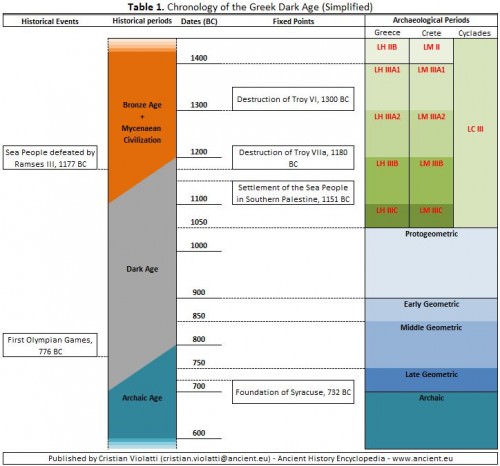
Table 1 - Chronology of the Greek Dark Age
COLLAPSE AFTERMATH
SETTLEMENTS DURING THE DARK AGE WERE GENERALLY SMALL AND SCATTERED ACROSS THE LANDSCAPE, AND THE MATERIAL CULTURE SHOWED SIGNS OF IMPOVERISHEMT COMPARED TO MYCENAEAN TIMES.
After the destruction of the Mycenaean palaces, there is no evidence that these buildings were rebuilt; it seems clear, however, that some of these sites were reoccupied, and that in some cases there were attempts to build new structures, although no real attempt to rebuild the old palaces can be identified. At Mycenae, the uppermost terraces were abandoned, but part of the citadel was reoccupied; at Dhimini, activities at the destroyed large palatial complex were partly restored, but abandoned soon after. Some aspects of Mycenaean culture continued to exist for about a century or so after c. 1200 BCE. In mainland Greece and some of the Cyclades islands, Mycenaean pottery and Mycenaean burials persisted.
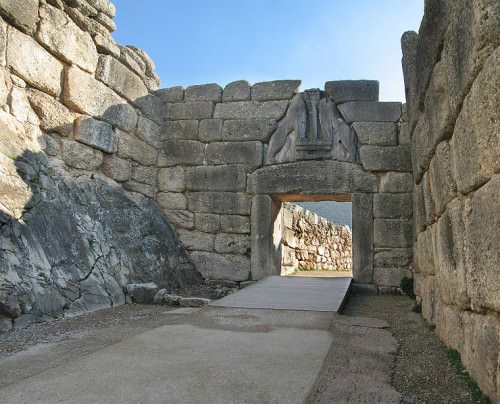
Lion's Gate at Mycenae
In Crete, although urban life continued in some coastal towns (eg Palaikastro), many major Bronze Age settlements were abandoned and a new pattern emerged: the location of new sites on remote and easily defensible areas. Some of these areas were not occupied prior to 1200 BCE. The site of Karphi is a good example: most of it lies over 1,000 metres above sea level.It seems unlikely that the people of Karphi freely chose to settle in a spot so difficult to access, so it is safe to assume that this choice was conditioned by a set of circumstances, probably linked to defensive and other strategic reasons. More than a hundred sites like this have been recorded in Crete alone.
BURIAL PRACTICES DURING THE DARK AGE
By about 1100 BCE, a number of changes can be identified in the archaeological record affecting burial practices, settlements, and pottery styles. In many regions, the Mycenaean custom of burial in family vaults was suddenly replaced by a new single burial practice, while cremation was adopted in some areas. Regional variations in burial practices have been identified and also different practices coexisting within the same community.
- Attica. In Athens, inhumation in pit and cist graves was a dominant burial practice recorded in the Kerameikos cemetery prior to 1050 BCE. Between 1100 and 1050 BCE, similar burial practices were used in Athens and Salamis and both places show little grave evidence for wealth distinction. During the Protogeometric period, cremation became the main funerary practice, and the incinerated remains were placed inside an amphora, which was then placed inside a pit along with grave goods, filled with earth, and covered by a stone slab. Gender distinction was emphasized in Athens: weapons and large kraters were linked to men, while jewelry and amphorae were connected to women. By the late 8th century BCE, inhumation became the dominant burial practice again.
- Euboea. In Lefkandi, both cremation and inhumation were practiced. Different variations existed for both: cremated remains could be placed in a cist or left on the pyre, and inhumations could take place in cist or shaft graves. In some towns, pit-inhumations were recorded under house floors. At Eretria a mix of cremation and inhumation was found in the same cemetery.
- Thessaly. Here some aspect of Mycenaean burial practices persisted, such as small tholos tombs (widely present during Mycenaean times), which continued to be built throughout the Dark Age. Several cist grave cemeteries (used largely for children in the beginning) are recorded, including multiple burials in rock-cut chamber tombs. Other practices include slab-covered pits dug in the floor of vaulted chambers (some of them containing cremated remains), cremation in cists, and pyres grouped together and covered by a communal tumulus.
- Crete. Chamber tombs remained in use in some areas (eg Knossos ) where collective burial was the norm, but many of the chamber tombs found here were abandoned after no more than two generations. Gender and age distinction was emphasized in Knossos through grave goods, but this practice is abandoned by the 10th century BCE.
SETTLEMENTS IN THE ARCHAEOLOGICAL RECORD
The study of settlements suggests a dramatic population decline in Greece during the Dark Age. This is reflected by the reduction in the number of settlements in Greece that can be identified around 1100 BCE: the amount of recorded sites and cemeteries of Greece during the LH IIIB and LH IIIC period clearly show this tendency (see figure 1). This is consistent with the figures propose by Anthony Snodgrass for the number of occupied sites in Greece identified on the basis of different pottery styles:
- c. 320 sites occupied in the 13th century BCE (based on Mycenaean IIIB pottery)
- c. 130 sites occupied in the 12th century BCE (based on Mycenaean IIIC pottery)
- c. 40 sites occupied in the 10th century BCE (based on Submycenaean + Early Protogeometric pottery)
In some areas of Greece, such as Laconia and the southern Argolid, very few archaeological findings have been identified for the c. 1100-1000 period, and the few sites that were found are small compared to previous times. Vincent Desborough has estimated a sharp population decline by c.1100 "about one-tenth of what it had been little over a century ago".
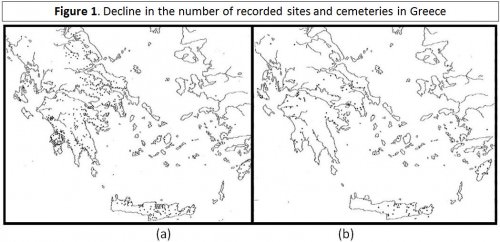
Figure 1 - Decline in the number of recorded sites and cemeteries in Greece
Settlements during the Dark Age were generally small and scattered across the landscape, and the variety of material culture showed signs of impoverishment compared to Mycenaean times. A different picture can be seen at the site of Lefkandi (in Euboea), considered the richest site in Greece, around 1000 BCE. Lefkandi has produced evidence of foreign contacts (Cyprus and the Near East) and also presents building that ranks well above any other contemporary building in Greece. As exciting as all these may sound, Lefkandi also reflects the material decline of Greece: in terms of building standards, Lefkandi ranks well below the level of sophistication of Mycenaean architecture. The Greek material culture in general became poorer during the Dark Ages, less innovative, and places like Lefkandi are rare exceptions rather than the rule.
POTTERY DURING THE DARK AGE
Like burials, pottery styles throughout Greece during the Dark Age saw the emergence of regional variations, unlike during Mycenaean times when pottery displayed a stylistic unit. During some time after the destruction of the palaces, the pottery industry continued during the LH IIIC period, but it eventually decreaded its quality, followed by the emergence of new regional pottery styles. An overview of the of the Greek regional pottery styles is presented in Table 2.
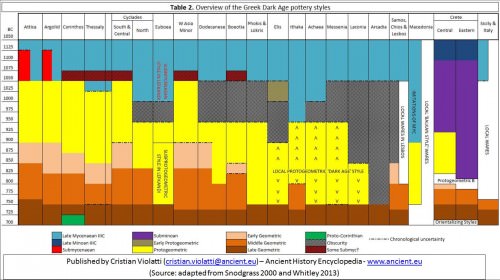
Table 2 - Overview of the Greek Dark Age pottery styles
Abstract decoration dominated the Dark Age pottery styles. Figurative art, largely absent during the Greek Dark Age and fairly common during Mycenaean times, returned during the late stage of the Geometric style, including battles, chariotprocessions, and funerary scenes. Only a few examples of figurative art in pottery have been recorded prior to the Late Geometric style (eg Early Protogeometric styles in Lefkandi and Crete).
About 1125 BCE, Attica saw the emergence of a local style known as "Submycenaean". This style has also been recorded in other regions, but it shows significant variations; in Lefkandi, for example, it displays a poorer quality when compared to Attica.In the Argolid there are differences in quality between different sites. Submycenaean style in general is below the standards of the Late Mycenaean style in terms of materials and painting quality. Late Mycenaean and Submycenaean styles coexisted until c. 1050 BCE, when the Protogeometric style replaced both and also appeared in the Argolid, Corinthos, Thessaly, South & Central Cyclades, and West Asia Minor. Between 950 and 900 BCE, the Protogeometric style was the most popular style in Greece, but it was absent in some regions: Elis, Laconia, Arcadia, and Samos & Chios (where there is no data available);Lesbos, Macedonia and Sicily & Italy (local wares have been recorded), and Eastern Crete (where the Subminoan style was used).
From 900 BCE onwards, the Geometric style gradually emerged until it replaced all earlier styles by 750 BCE, except in Macedonia. Around 725 BCE, the Pro-Corinthian style emerged in Corinth, and shortly after other fully figurative styles were also detected in Crete.
Regional variation of pottery can be interpreted as a loss or reduction in the level of contact between the different groups: styles of decoration are typically borrowed and exchanged during interaction between groups. The lack of an overall unifying artistic tradition, linked to the absence of a dominant political unit in Greece, could also be a factor to consider when trying to explain these regional differences. Influences from foreign pottery styles are only recorded in rare cases (eg Lefkandi and Athens).
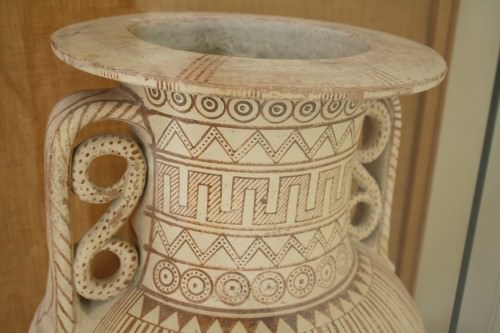
Geometric Pottery Designs
PAST VIEWS ON THE GREEK DARK AGE
Several decades ago, scholars had a rather different view on the Greek Dark Age compared with our current understanding.The Mycenaean civilization, it was believed, fell after several waves of invasions by different groups who brought violence and chaos to the sophisticated Mycenaeans. "Dark Age" was a suitable analogy for this apocalyptic view of a complex society being torn apart by nomads entering Greece and "downgrading" it to an age of savagery. This picture was mainly supported by ancient accounts on the Dorian invaders, a Greek tribe that migrated into Greece, that was largely responsible for the Mycenaean collapse. It was believed that the Dorians
...were still in the herding and hunting stage; [...] their main reliance was upon their cattle, whose need for new pasturage kept the tribes ever on the move. [...] the hard metal of their swords and souls gave them a merciless supremacy over Achaeans and Cretans who still used bronze to kill. [...] [the Dorians] put the ruling classes to the swords, and turned the Mycenaean remnant into helot-serfs. [...] The surviving Achaeans fled [...] every man, feeling unsafe, carried arms: increasing violence disrupted agriculture and trade on land, and commerce on the seas. War flourished, poverty deepened and spread. Life became unsettled as families wandered from country to country seeking security and peace.(Durant: 62-63)
Scholars in the past took the ancient accounts of the Dorians and other invading groups at face value. Rather than having a critical view on these sources, they looked for evidence that could confirm their validity. As a result, it was proposed that some of the archaeological evidence found around 1200 BCE was a reflection of these newcomers. Single burials and cremations, were seen as an "intrusive" new element in the archaeological record, usually associated with the Dorians: these were understood as new funerary practices alien to the Mycenaean world and introduced by the invading tribes. It was a "confirmation" of the ancient account on invading groups.
From 1960s CE onwards, the archaeological work on the Greek Dark Age has been increasing significantly, and many of the old assumptions have been challenged. Single burials, for example, have been identified throughout the Mycenaean period at Argos. Cremation, another "intrusive" element, has also been recorded during Mycenaean times in western Anatolia, Attica, and even in Italy. This means that we have reasons to believe that those funerary expressions that were interpreted in the past as a ''proof" of invading groups entering Greece might actually have an indigenous Mycenaean origin or even an origin in neighbouring regions with strong commercial links to the Mycenaean world, such as Italy. It may be the case that Dorian tribes migrated into Greece around the time of the Mycenaean collapse, and it might also be possible that they played a role in the collapse itself, but the point is that the evidence for it is far from conclusive, and it has no solid archaeological basis.
CRITICISM OF THE TERM "DARK AGE"
A number of scholars have raised concerns about the term "Dark Age". James Whitley has stated that the term Dark Age is a "rather loaded term". Timothy Darvill believes that the term "Dark Age" is "not very helpful" because it implies that very little is known about the period despite the fact that the archaeology has advanced our knowledge of the Greek Dark Age. Based on these and other observations, there are a few alternatives to refer to this period, such as "Early Iron Age" (based on the "Three Age" system), which can be divided in "Protogeometric" (1050 BCE to 900 BCE) and "Geometric" (900 BCE to 700 BCE) Greece.
Despite these new objections on the term "Dark Age", the overall picture suggested by archaeological data for this period fits the general features of system collapse with no identifiable central administration, population decline, and impoverishment of material culture. This is in line with the opinion of Anthony Snodgrass who holds that in Greece during the Dark Age, little was preserved from the Mycenaean culture and "that little then dwindled away to almost nothing, until some elements were artificially revived in the late "8th century BCE and later'.
RECOVERY & TRANSITION INTO THE ARCHAIC PERIOD
By 800 BCE the number of settlements began to rise. This growth is recorded in mainland Greece in general, the Aegean islands, and it is also reflected in the growth of the number of Greek settlements outside Greece (Western Mediterranean and the Black Sea). The increase in the number of settlements is in line in the growing number of graves at Athens, Attica, and Argos during the 8th century BCE. The same pattern has been recorded in Knossos and other cemeteries across Greece. The material culture of the8th-century-BCE Greece is much varied and innovative compared with the previous centuries. Other changes recorded towards the end of the Dark Age are: recovery of literacy ( Greek alphabet ) after the abandonment of the Mycenaean Linear B script, increasing contacts with regions outside the Aegean, and the emergence of a new and successful form of political institution (the early poleis ). These signs are consistent with a society experiencing a population increase and gaining a higher level of complexity.
This time of recovery marks the end of the Greek Dark Age and the transition into the Greek Archaic Period, a time considered a turning point or revival in Greek history.
Pizarro and Atahualpa: The Curse of the Lost Inca Gold › Who Was
Ancient Civilizations
In November 1532 CE, Francisco Pizarro led a group of about 160 conquistadors into the Inca city of Cajamarca. The illiterate and illegitimate son of an Extremaduran nobleman and an impoverished woman, Pizarro had spent his entire life on a quest to become wealthy and be remembered.

Francisco Pizarro
After hearing of how a distant cousin of his, Hernan Cortes, had looted millions in gold from the Aztecs, Pizarro was desperate to do the same. He began his career when in 1502 CE, he joined a colonization expedition to the New World. Distinguishing himself in battle, Pizarro quickly rose to second-in-command of the Darien region's army.
He led two unsuccessful expeditions into the western coast of South America, where harsh conditions and native warriors drove his troops back towards the shore. However, fate was to intervene when Pizarro's troops entered the Inca City of Tumbes. The people of the village not only welcomed them, but allowed the conquistadors time to rest and heal.
Quickly the Spaniards became enthralled with not only the large amounts of silver and gold the local chieftains wore, but that the precious metals seemed to be everywhere. Using tactics and subterfuge, they persuaded the chieftains to tell them of a great Inca ruler in the mountains where gold was plentiful.
Taking his new found knowledge and some gold as proof, Pizarro returned to Spain, where he convinced King Charles to not only finance a third expedition, but to make him the governor of all lands he conquered.
Upon Pizarro's return to Tumbes, he found the once beautiful city destroyed by civil war. Pizarro didn't know it at the time, but his timing could not have been more perfect, as shortly before his arrival Atahualpa Inca had returned from the conquest of defeating his brother Huascar. The battle's outcome had made Atahualpa the “Inca” (only the King could actually use the term Inca.) Upon hearing of the Spaniards arrival, Atahualpa felt he and his 80,000 men had little to fear from the 160 Spaniards.However, as a precaution he sent a few nobles to meet with the Spanish.
The nobles spent two days with the Spaniards, accessing them and their weapons. When he heard their report, Atahualpa sent word that he wished to meet the Spanish at the city of Cajamarca, where he planned to capture them.
When Pizarro entered the mostly deserted city in November, he immediately sent word that he would like to meet with the great Inca ruler at the city's center. As he waited for the Inca's arrival, Pizarro planned a trap of his own. Atahualpa arrived at their meeting point carried in a litter by 80 noblemen and surrounded by 6,000 soldiers. Shortly afterwards, Pizarro ordered the attack. Cannons began to roar with deadly accuracy. The cavalry charged from their strategically hidden positions, and the infantrymen opened fire from long houses. The Inca soldiers and nobles who weren't killed in the first few minutes of the attack fled in fear. Pizarro himself captured Atahualpa Inca.
Fearing for his life, Atahualpa told Pizarro if he would spare him, within two months his people would fill a room 24-feet long by 18-feet wide and a height of 8-feet with gold, and twice that amount with silver. Even Pizarro was taken aback by this amount of wealth and instantly agreed to the ransom.
However during the two months the gold and silver were slowly delivered, the Spanish troops and Pizarro lived with the growing and overwhelming fear that the massive Inca army may be mobilizing to take Atahualpa and kill them.
To prevent this from happening, on August 29, 1533 CE, Pizarro acted as judge, and on the basis of false charges sentenced Atahualpa to burn at the stake. Hearing of his verdict the Inca ruler asked if he could convert to Christianity. He knew if he were a Christian, the Spanish religion would not allow him to be burned to death, and he was right - instead they garroted him.
Upon learning of the Spanish treachery, Inca General Ruminahui hid the approximate 750 tons of gold he was bringing for his king's release in a cave deep in the Llanganatis Mountains. Shortly afterwards Ruminahui was captured, and while tortured to death, he did not reveal the treasure's location.

Inca General Ruminahui
There the treasure remained for many years until a Spanish man living in the Llanganatis Mountains - Valverde Derrotero - married a certain village priest's daughter. The priest sometime earlier had found the treasure and knowing of the Spanish lust for gold, he showed his new son-in-law its whereabouts. Derrotero had been a poor man, but after the marriage he became a very rich one. Some years later he returned to Spain and upon his deathbed wrote a three-page edict to the king, declaring the treasures location. Known as Valverde's Guide, the piece gave detailed instructions on how to find the treasure.
Immediately the king dispatched a friar named Father Longo to inspect the possibility of hidden treasure. During his expedition Longo sent word that they had found the treasure, but on his way back down the mountains he mysteriously disappeared.
About 100 years after Longo's disappearance, a miner named Atanasio Guzman, who had been mining in the Llanganates Mountains, penned a map, which he said led to the treasure. However, before he could lay stake to his claim he, much like Longo, disappeared in the mountains.
Nothing else was known about the treasure until 1860 CE, when two men --Captain Barth Blake and Lieutenant George Edwin Chapman-- believed they had solved the riddle set in search of the treasure. Blake made maps of the area and sent communication back home. In one of his letters he wrote:
It is impossible for me to describe the wealth that now lays in that cave marked on my map, but I could not remove it alone, nor could thousands of men … There are thousands of gold and silver pieces of Inca and pre-Inca handicraft, the most beautiful goldsmith works you are not able to imagine, life-size human figures made out of beaten gold and silver, birds, animals, cornstalks, gold and silver flowers. Pots full of the most incredible jewelry. Golden vases full of emeralds.
However, the men were not to enjoy their spoils, as on their way out of the mountains, Chapman disappeared, and Blake --a career naval officer-- somehow fell overboard while transporting some of the gold to be sold.
Is the story true? It's difficult to be certain, but we know a tremendous amount of gold and silver was delivered to the Spaniards. There are the historical accounts of people disappearing, or in Blake's case falling overboard, after announcing they had found the treasure.
There's also the fact that in one of his cryptic clues to the Spanish King, Derrotero mentioned a Black Lake. Sometime in the 1930's CE, the Yanacocha (or Black Lake) gold mine went into operation. To date the mine has produced more than $7 billion US dollars in gold. And, while finding gold in the area Derrotero said the treasure would be doesn't necessarily make the story true, it does make it worth its weight in gold.
LICENSE:
Article based on information obtained from these sources:with permission from the Website Ancient History Encyclopedia
Content is available under License Creative Commons: Attribution-NonCommercial-ShareAlike 3.0 Unported. CC-BY-NC-SA License